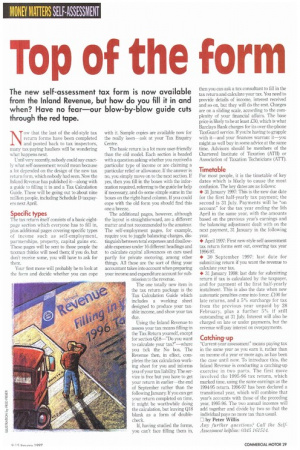Top of the form
Page 31

If you've noticed an error in this article please click here to report it so we can fix it.
The new self-assessment tax form is now available from the Inland Revenue, but how do you fill it in and when? Have no fear—our blow-by-blow guide cuts through the red tape.
Now that the last ul the old-style tax return forms have been completed and posted back to tax inspectors, many nix-paying hauliers will be wondering what happens next.
Until very recently, nobody could say exactly what self-assessment would mean because a lot depended on the design of the new tax return form, which nobody had seen. Now the Inland Revenue has published it—along with a guide to filling it in and a Tax Calculation Guide. These will be going out to about nine million people, including Schedule I) taxpayers next April.
Specific types
The tax return itself consists of a basic eightpage section which everyone has to fill in, plus additional pages covering specific types of income such as self-employment, partnerships, property, capital gains etc. These pages will be sent to those people the taxman thinks will need them; if you do, but don't receive some, you will have to ask for them.
Your first move will probably be to look at the form and decide whether you can cope with it. Sample copies are available now for the really keen—ask at your Tax Enquiry Centre.
The basic return is a lot more user-friendly than the old model. Each section is headed with a question asking whether you received a particular type of income or are claiming a particular relief or allowance. If the answer is no, you simply move on to the next section. If yes, then you fill in the boxes with the information required, referring to the guide for help if necessary and do some simple sums in the boxes on the right-hand column. If you could cope with the old form you should find this one a breeze.
The additional pages, however, although the layout is straightforward, are a different matter and not recommended to the amateur. The self-employment pages, for example, require you to juggle balancing charges, distinguish between total expenses and disallowable expenses under 16 different headings and to calculate capital allowances on cars used partly for private motoring, among other things. All these are the sort of thing your accountant takes into account when preparing your income and expenditure account for submission to the revenue.
The one totally new item in the tax return package is the Tax Calculation Guide which includes a working sheet designed to produce your taxable income, and show your tax due.
Using the Inland Revenue to assess your tax means filling in the Tax Return yourself, except for section Q18—"Do you want to calculate your tax?"—where you tick the No box. The Revenue then, in effect, completes the tax calculation working sheet for you and informs you of your tax liability The service is free but you have to get your return in earlier—the end of September rather than the following January. If you can get your return completed on time. it might be worthwhile doing the calculation, but leaving Q18 blank as a form of doublecheck.
If, having studied the forms, you can't face filling them in, then you can ask a tax consultant to fill in the tax return and calculate your tax. You need to provide details of income, interest received and so On, but they will do the rest. Charges are on a sliding scale, according to the complexity of your financial affairs. The base price is likely to be at least £50, which is what Barclays Bank charges for its over-the-phone TaxGuard service. If you're having to grapple with it—and your finances warrant it—you might as well buy in some advice at the same time. Advisors should be members of the Chartered Institute of Taxation (ATU) or Association of Taxation Technicians (ATT).
Timetable
For most people, it is the timetable of key dates which is likely to cause the most confusion. The key dates are as follows: • 31 January 1997: This is the new due date for the first half-yearly tax payment; the second is 31 July. Payments will be "on account" for the tax year ending the 5th April in the same year, with the amounts based on the previous year's earnings and the balancing adjustment dealt with on the next payment, 31 January in the following year.
• April 1997: First new-style self-assessment tax return forms sent out, covering tax year 1996-97.
• 30 September 1997: last date for submitting return if you want the revenue to calculate your tax.
• 31 January 1998: last date for submitting return if tax is calculated by the taxpayer, and for payment of the first half-yearly instalment. This is also the date when new automatic penalties come into force: £100 for late returns, and a 5% surcharge for tax from the previous year unpaid by 28 February, plus a further 5% if still outstanding at 31 July. Interest will also be charged on late or under payments, but the revenue will pay interest on overpayments.
COkiling-Up "Current-year assessment" means paying tax in the same year as you earn it, rather than on income of a year or more ago, as has been the case until now To introduce this, the Inland Revenue is conducting a catching-up exercise in two parts. The first move involved the 1995-96 tax return, which marked time, using the same earnings as the 1994-95 return. 1996-97 has been declared a transitional year, which will combine that year's accounts with those of the preceding year, 1995-96. The two annual incomes will add together and divide by two so that the individual pays no more tax than usual.
0 by Peter Willis Any further questions? Call the SelfAssessment helpline: 0345 161514.
































































































